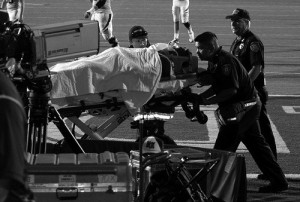There are a select few sports that most will never compete in because they are simply put, likely to cause pain, but cheerleading and golf? Seriously? Believe it or not, these activities that are often considered tame or not even sports at all can be unexpectedly dangerous. Bring your first-aid kits and Advil, this could get ugly.
An examination of the frequency of injuries in certain sports reveals that while the common conceptions of violent sports remain accurate, there are definitely some surprises. For this report, rates of death, catastrophic injury and injury in general determine rankings in descending order of importance.
1.) Football
In 2008, there were 14 football-related deaths in high school football in the country; a rate of 1 in every 106,383 players, according to the National Center for Catastrophic Sports Injury Research (NCCSIR). This tally is the highest of any major high school sport. However, new equipment including better helmets is continually making the game safer. Also, the technique of tackling opponents by “spearing” them with one’s helmet is now illegal, drastically cutting down on neck and spinal injuries. Over the past 40 years, the death toll has decreased steadily from a high of 36 in 1968.
2.) Skiing
Hurtling down a snowy slope on a pair of greased two by fours is bound to be wrought with dangers. According to the National Ski Areas Association (NSAA), 1 of every 400,000 skiers and snowboarders die on the slopes. That works out to an average of 34 per year over the past 13 years. Aside from death, more than 20,000 skiers in the United States suffer from anterior cruciate ligament (ACL) injuries each year according to the Big Bear Valley National Ski Patrol website. Thanks to newer skis that disengage the bindings in a crash, lower-leg breaks are much less frequent.
3.) Cheerleading
Cheer is no longer all pom-poms and fun chants. Cheerleading accounts for 67 percent of all high-school female catastrophic injuries (death or severe head or neck injury) according to the NCCSIR. Unlike football, cheerleading is becoming ever more dangerous due to more extreme stunts. This, compounded with a lack of proper coaching and training for such maneuvers, leads to many severe injuries. It is not uncommon for a cheerleader to fall through the awaiting arms of her fellow athletes after sailing high into the air, causing broken bones, internal injuries and death.
4.) Rugby
Rugby is essentially football but without pads. Only thin helmets and mouth-guards protect these athletes. According to the British Columbia Injury Research and Prevention Unit, rugby players are almost three times as likely to sustain an injury as football players are, but less likely to sustain a fatal injury. During a single season, as many as one in four players will be injured.
5.) Bicycling
Wear your helmet! Next time you hop on your bike, think twice about leaving the lid at home. In 2004, 900 bicycle riders in the United States were killed by cars, a rate of about 1 in every 45,000 bikers according to the National Safety council. Head injuries cause three out of every four deaths related to bicycling, according to the Johns Hopkins Injury Prevention Center . Despite such high rates, riders using biking as a mode of transportation make up much of the total.
6.) Golf
Golf, believe it or not, has a significant number of injuries each year. According to the American College of Sports Medicine, 60 percent of professional and 40 percent of amateur golfers suffer from injury each season. However, the vast majority of these are merely from overuse or strain. Also, lightning strikes to players are relatively common, with 5 percent of all lightning strikes occurring on the course.






